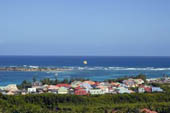
Purpose
To determine if the external color of a structure can affect the internal temperature of the structure under different environmental conditions.
Additional information
Never buy a black car! You'll hear that most often in areas where the temperatures routinely reach the triple digits, such as Arizona. It's a common belief that the external colors of structures or objects have significant impact on the internal temperatures for varying climate conditions. It's hypothesized that the darker the external color, the hotter the internal temperature will be.
We'll be putting the color theory to the test by mimicking the affects dark and light colors have on buildings and how they may affect energy costs.
Sponsored Links
Required materials
- 3 average and equaled sized shoe-boxes. If shoe boxes aren't available, you can sub standard boxes as long as they remain the same size and are no bigger than the size of a shoe box.
- 4 standard thermometers (non-digital)
- a heat lamp
- ice
- a large tray (to hold the ice)
- rock salt or sea salt
- a white plastic bag
- paint that includes the colors white, black, and grey (you can make grey by mixing the black and white if necessary)
- a paint brush
- a notepad and pen (to record results)
Estimated Experiment Time
About 3 hours to set-up and capture several samples
Step-By-Step Procedure
- 1. Paint the shoe boxes. Paint the first one white, the second one black, and the third one gray. Wait for the paint to dry before moving on to the next step.
- 2. While your waiting for the paint to dry, place your 4 thermometers on a flat surface so they can all adjust to room temperature.
- 3. Line the boxes in a row on a table or flat surface.
- 4. Place one thermometer under each box.
- 5. Place the remaining thermometer on the table or surface outside the boxes.
- 6. Record the starting temperature of each thermometer. It's best to create a chart similar to the following:
| Box Color | Starting Temp | Room Temp | Heated Temp | Cooled Temp |
|---|
| None | | | | |
| White | | | | |
| Grey | | | | |
| Black | | | | |
Make sure to record the starting temperatures under the "Starting Temp" column.
- 7. Place the lids on each of the boxes and leave for at least 30 minutes.
- 8. After 30 minutes, record the temperatures of each thermometer under the "Room Temp" column.
- 9. Replace the lid on each box. It's time to simulate a hot summer day!
- 10. Place a heat lamp above all three boxes. Ensure the boxes are getting the same amount of heat dispersement by ensuring they are of equal distance and height from the heat lamp. For the external thermometer, it's best if it's placed between two of the box on the table (in the center of the heat source). Let the boxes sit under the heat lamp for at least 30 minutes.
- 11. After 30 minutes, record the temperatures of each thermometer under the "Heated Temp" column.
- 12. The final phase of the experiment will be to heat the boxes while they're influenced by a cold surface. This will be similar to simulating the effects of a sunny day after a winter storm.
- 13. Place your ice on a flat tray and sprinkle the ice with your rock salt (or even sea salt). Place a white plastic bag over the ice tray so we can keep the bottoms of our boxes dry.
- 14. Place all three boxes evenly on the ice tray and place the external thermometer on the ice tray between two boxes (as before, in the middle of the ice tray is best).
- 15. Place the heat lamp as you did previously, making sure all boxes get an even amount of heat.
- 16. After 30 minutes, record the temperatures of each thermometer under the "Cooled Temp" column.
Note
Be VERY careful when handling the heat lamp! Heat lamps can cause serious injury or even a fire if dropped onto the boxes. If need be, get an adult to help you or to supervise.
Observation
What variances did you observe in the temperatures? Did one box give off a higher temperature under heated conditions that the others? Which box did you observed to stay the coolest? How much of a variance was there from the external temperature?
Result
By the end of the experiment you should have results that indicate the darker boxes gave off the most amount of heat. Our experiment proves the scientific fact that lighter colors reflect energy rays while darker colors absorb them. Therefore, the external color of structures and objects does affect the internal temperatures.
Sponsored Links
Take a moment to visit our table of Periodic Elements page where you can get an in-depth view of all the elements,
complete with the industry first side-by-side element comparisons!